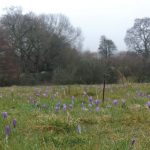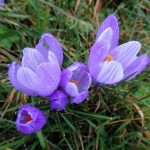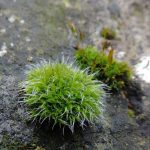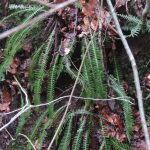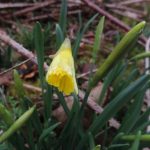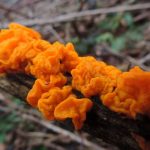On Saturday 10 March, Jan and Laurie Haseler led a walk round Inkpen Crocus Field, a nature reserve of the Berkshire, Buckinghamshire and Oxfordshire Wildlife Trust (BBOWT). It was a grey, damp morning, but the thousands of crocuses still managed to put on a fine display. The entrance to the field was a haze of purple, with the occasional white specimen scattered around. Bright green feathery leaves of Pignut pushed up through the grass. The path led across the valley of a small stream and up onto the far side of the field, where there were much lower numbers of crocuses. Greenfinches flew along the hedge and a Woodpecker drummed nearby. The origin of a skull attached to a long robust neck was discussed, with some sort of small deer the most likely candidate.
The walk continued along trackways to BBOWT’s Inkpen Common reserve. The first footpath led past a thatched cottage with two staddle stones in front of its gateway. The tops of the stones were covered in mosses, including grey-green cushions of Grimmia pulvinata and brighter green patches of Tortula muralis. The footpath led through a Beech wood and down into a stream valley. The stream had carved a deep channel and on the banks were a selection of ferns, including Common Polypody, Hard Fern, Scaly Male Fern and Soft Shield Fern. First stop inside the reserve was a big clump of daffodils. Their small size, narrow grey-green leaves, golden yellow trumpets and pale yellow outer perianth segments all indicated that they could be genuine Wild Daffodils. The yellow jelly fungus Tremella mesenterica was found on a dead Gorse branch nearby. Gorse and Bracken had recently been cleared from a sizeable area on the south-west side of the reserve. The walk continued along a boardwalk which crossed a stream and an area of mire, where the leaves of Bog-rosemary were spotted. Two ponds on the south-east side of the reserve showed no signs of life, perhaps not surprising, since a week before they had been covered by thick ice. The walk continued round the common, following wide grassy pathways through sections of heather and managed Gorse. Grazing livestock are used to help maintain the open structure of the common. The footpath back to the sports field led first through a Beech wood, then through a very muddy section where a dense thicket of birch trees had grown up amongst planted pines.
Pictures by Rob Stallard

